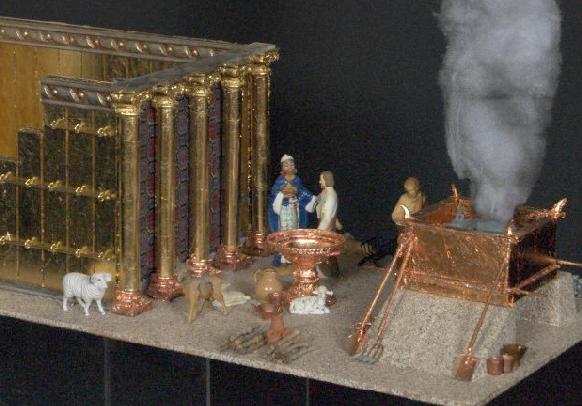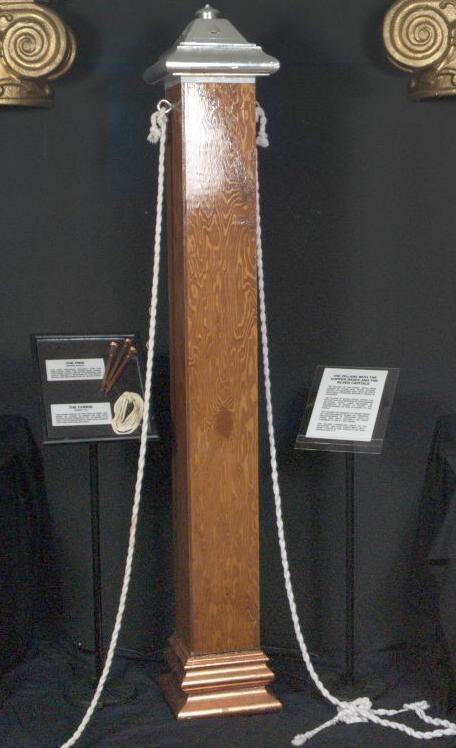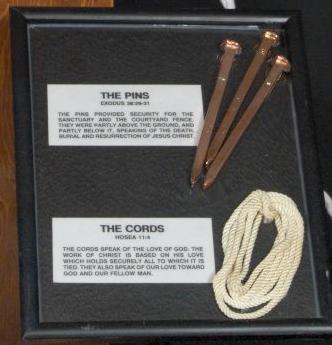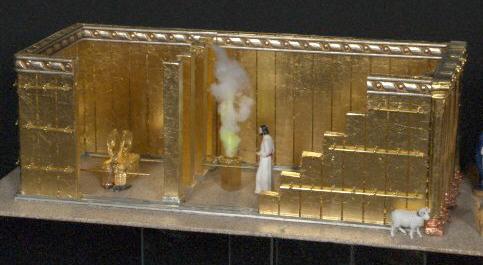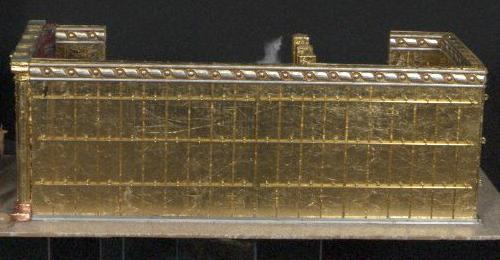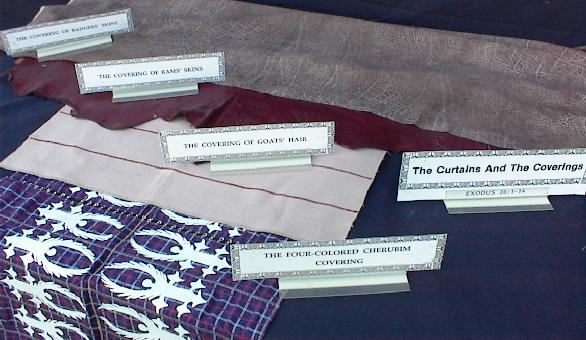| Ark of the Covenant for Sale,The tabernacle,Old Testament,Most Holy Places,Golden Candlestick,Shewbread,Veil,Ark of the Covenant,Mercy Seat,Menorah,Altar of Incense,Brazen Altar,Solomons Temple,Dome of the Rock,Noah's Ark,1904 World Fair,Banners for sale,Ark of the Covenant for Sale,Biblical Artifacts,Ark of the Covenant | |||||||||||||||||||||||||||||||||
 |
|||||||||||||||||||||||||||||||||
 |
|||||||||||||||||||||||||||||||||
| [The Tabernacle] [The Tabernacle Poem] | |||||||||||||||||||||||||||||||||
|
The TabernacleContents
The Architecture of the Tabernacle |
The Court of the Tabernacle |
One of the Sixty Court Pillars |
The Copper Pins and Cords |
The Altar of Burnt-Offering |
The Sanctuary in the Tabernacle |
The Golden House |
The Holy Place |
The Most Holy Place OverviewA thorough understanding of the details of the primitive Tabernacle of Israel is essential to grasp fully the fundamental principles involved in the construction of King Solomon's Temple. An intimate knowledge of the Tabernacle's contents and their relation to one another is necessary to comprehend the ritualistic system developed by Solomon and his priests. A study of the ceremonies, the sacrificial offerings, and the priestly ministrations of the Tabernacle will reveal the great spiritual mystery of the Indwelling God, as made manifest by Moses during the sojourn in the wilderness. Moses, during his prolonged stay of forty days and forty nights on Mt. Sinai, appears to have visualized the form which the Tabernacle should take. The subsequent building of the Tabernacle, the system of worship adopted, and the structure of government developed by Moses under divine guidance, have inspired his race and impressed the whole of mankind. Moses chose as his chief architect, Bezaleel, a direct descendant of Terah, one of the master builders of Ur of the Chaldeans, and as chief assistant, Aholiab, also a direct descendent of Terah and by marriage of the line of Tubal-cain, traditionally the first instructor of artificers in brass and other metals. Bezaleel was unusually endowed with the Spirit of God in wisdom, understanding and knowledge. These three outstanding geniuses gave to the world the most beautiful and magnificent religious structure ever conceived and erected for a nomadic people. (Exodus 24-31; Genesis 4:22.) The Architecture of the TabernacleBack to topThe Tabernacle, Tent, or Portable Temple, being so
constructed that it could be readily taken down, moved from place to place, and
erected at will, was especially adapted to the needs of a nomadic people. Being
constructed on geometrical and scientific principles, it readily lent itself to
a practical system of removal and erection which was essential in the case of so
large and costly a structure. The Tabernacle consisted of an oblong or
rectangle, called the Court, in the rear half of which was the tent or covering
of the Sanctuary. Under this Tent, the Holy and Most Holy Places were defined by
partitions of boards and pillars, securely joined by means of rods, rings, etc.
A careful study of the entire structure reveals an architectural gem, servicably
conceived, beautifully designed, mystically embellished, celestially canopied,
and inspiring the beholder with profound reverence and peaceful security in the
thought of an ever present and Indwelling God, and typifying the encampment of
the Angels of the Lord around about them that fear Him. The Court of the TabernacleBack to topThe Court, the walled curtain of which surrounded the enclosure containing the Holy and Most Holy Places, with their furnishings - the Tent, Laver, Altar of Sacrifice, bowls and other sacrificial utensils - was oblong in shape; "100 cubits long and 50 cubits wide" (150 feet by 75 feet - A cubit was a Standard of measurement adopted by ancient builders, the distance from the elbow to the end of the middle finger.) Exodus 27:9-19;Exodus 38:9. One of the Sixty Court PillarsBack to topThis court was enclosed by a wall "5 cubits high" (7 1/2 feet), composed of linen and canvas, supported by pillars of brass, which rested in sockets of brass. The pillars were ornamented at the top with capitals of silver, to which were attached hooks of silver to hold in place the rods. The rods kept the pillars an equal distance apart and supported the canvas or linen wall. The Copper Pins and CordsBack to topThis wall was further supported by guy ropes attached to copper pins driven into the ground on both sides. This enclosure, composed of 60 pillars of brass, filleted with silver, with their 60 capitals of silver, 60 sockets of brass, and 120 hooks of silver, was only broken on the eastern side by the entrance, which was "20 cubits wide" (30 feet). This entrance, or gate curtain, was of fine twined linen, wrought with needle work in the most gorgeous shades of blue, purple, and scarlet. One can visualize its appearance and effect as it stood in the midst of the encampment of Israel. The Altar of Burnt-OfferingBack to topThe Altar stood in the midst of the eastern half ofthe oblong Court enclosure, the sacrificial tables and utensils being upon the left of the main entrance within the Court. The Altar of Burnt-offering was the instrument used for the purpose of reconciling man with his Maker. The Altar was 5 cubits long, 5 cubits broad and 3 cubits high (7 1/2 feet by 7 1/2 by 4 1/2). It was a large hollow case, made of shittim wood, overlaid with brass, and ornamented with huge wooden horns overlaid with brass, one for each of the four corners. A grating or network of brass, having a ring at each of its four corners, was hung in the middle of the top of the Altar, and on it was laid the wood for the fire which consumed the sacrifice. On two sides of the Altar were rings of brass, through which were laid staves of shittim wood overlaid with brass, to carry it from place to place. The pots, shovels, basins, flesh-hooks and fire pans, as well as all other vessels or utensils necessary to the service of the Altar, were made of brass. Exodus 27:1-8; Exodus 38:1-7. The Sanctuary in the TabernacleBack to topThe Sanctuary was erected in the center of the western half of the oblong Court enclosure, and consisted of two chambers, the Holy Place and the Most Holy Place. The tent, or covering, protected and formed a cover round about the Sanctuary, and was used by the priests and attendants as chambers or rest rooms. The western end and the two sides of the Sanctuary were enclosed by boards made of shittim wood overlaid with gold. The length of one board was10 cubits (15 feet), and the breadth was 1 1/2 cubits (27 inches). Each board had two tenons at the base equally distant one from the other, with two sockets of silver for each board to fit the tenons and form the foundation. On the outside of each board were rings to receive the bars to join one board to the other. There were 20 boards for the north side and 20 boards for the south side, held in place by five bars for each side. Four bars joined in the center of the wall and one bar passed through all the rings of the 20 boards, on each side. The Most Holy Place was divided from the Holy Place by four pillars of shittim wood overlaid with gold, resting upon sockets of silver. These pillars supported a hanging of most sumptuous tapestry of fine twined linen, a splendid fabric in blue, purple, and scarlet, beautifully embroidered with cherubim in gold. The Golden HouseBack to topFor the western end of the Sanctuary there were six boards and twelve tenons, with two corner boards and four tenons. They were so cut and coupled together as to form a perfect right angle for each corner, coupled at top and bottom. All the boards stood upright, edge to edge. A most beautiful covering of splendid linen fabrics in blue, purple, and scarlet, embroidered with figures of cherubim in gold formed the canopy for the two sacred rooms. This, together with the two hangings previously described and the boards of gold, produced an enchanting effect in gorgeous colorings, dazzling beyond description. The covering was composed of ten curtains of fine linen all in blue, purple and scarlet. Each curtain was 28 cubits (56 feet) long and the breadth of 4 cubits (6 feet). The ten curtains were joined permanently into two great curtains of five each by means of couplings. On one edge of one of the great curtains were loops of blue, 50 in number; on the edge of the other great curtain were taches of gold, 50 in number. The loops and taches coupled the curtains together into a one-piece covering. This splendid fabric of blue, purple, and scarlet colored linen, magnificently embroidered with figures of cherubim, formed the ceiling of both the Holy and Most Holy Places. It was drawn down on the outside of the golden boards and fastened to the center rod upon all sides except the eastern entrance. To protect this beautiful and delicately wrought covering, eleven curtains of goats' hair were provided, each 30 cubits (45 feet) long and 4cubits (6 feet) wide. Five of these curtains were permanently united into one great curtain and six into another. These in turn were provided with 50 loops on the edge of one curtain and 50 taches opposite the loops. The two composite curtains were joined to make one great covering carefully drawn over the entire Sanctuary and securely fastened on all sides except the eastern entrance. To complete the protection against inclement weather, a tent, oblong in shape, was also provided, consisting of two coverings, an inner one of rams' skin, dyed red, and an outer of badgers' skins. The tent had a ridge over which the coverings were drawn and then fastened by means of guy ropes to pins driven into the ground at regular intervals upon all sides. The Holy PlaceBack to topThis was an oblong room 20 cubits in length, 10
cubits in width and 10
cubits in height (30 feet by 15 by 15). The entrance gate consisted of a
beautiful tapestry of blue, purple, and scarlet fabric, gorgeously
embroidered with cherubim in pure gold. The tapestry was hung upon five pillars
of wood overlaid with gold, having beautiful capitals of silver and sockets of
brass. The pillars, which were arranged in regular interval across the east
entrance of the room, had hooks at the very top of the capitals to receive the
loops at the top edge of the curtain or veil of the Tabernacle, which was thus
suspended across the entire front at the west so as to separate the Holy from
the Most Holy Place. Above, and forming the ceiling, was the brilliant colored
linen covering, and on the north and south sides were the highly polished golden
walls reflecting in radiant splendor the varied colored drappings and richly
rugged floor. The Most Holy PlaceBack to topThe second or inner chamber, called the Most Holy Place, was 10 cubits (15 feet) on each side and consequently a perfect cube. It contained the Ark of the Covenant, in which were the two Tables of Stone. This place, the Holy of Holies, the most sacred portion of the divinely appointed structure, was surrounded on three sides by highly polished walls of pure gold. The "Veil" of fine twined linen in blue, purple, and scarlet, richly embroidered and ornamented with figures of cherubim in gold, hanging from the tops of four pillars of shittim wood overlaid with pure gold, and resting in sockets of silver, defined the eastern and only entrance. Over all this magnificent, foursquare, resplendent place hung the blue, purple, and scarlet curtain, richly embroidered with golden cherubim. The reflection of these brilliant hues, and of the Cherubim, upon the walls of polished gold, must have produced a weird, startling, awe-inspiring and overpowering effect upon all those who were ordained to enter this most sacred place. Within this enclosure there was but one article of furniture and its contents, that is, the Ark of the Covenant containing the Testimony. The comprehensiveness of the Tabernacle, its hidden grandeur, and its mysterious splendor, appealed to David to such an extent that he longed to build, with the Tabernacle as a model, a permanent Temple dedicated to the worship of the true God. David loved the Tabernacle as the house of the Lord. He desired to dwell in its courts forever, that he might behold the glory of God, make manifest His eternal presence, and sing His praise. David had the Tabernacle ever in mind when he prepared plans and patterns for the Temple to be erected upon Mount Moriah, the most sacred spot on Earth. He bequeathed the plans to Solomon, who with the Tabernacle as a guide, erected a Temple the grandeur of which has so impressed the world that men, never tiring in its praise, have placed it foremost in legend, romance, history, and religion. The Tabernacle was the pattern which guided the master builders in the construction of King Solomon's Temple, as well as the priests in its ritualistic services. The physical Temple was completed about 1005 B.C. according to the received chronology. 1 Chronicles 28:11-21. |
||||||||||||||||||||||||||||||||
|
Home |
The Tabernacle |
The Furniture |
The High Priest |
Service Vessels |
Informative Pieces |
Architectural Models
Copyright © 2005. Mishkan Ministries. All rights reserved. |
|||||||||||||||||||||||||||||||||


















